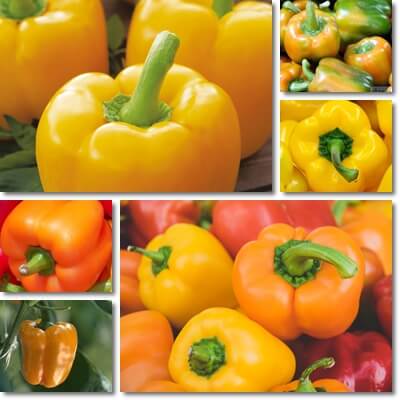Yellow and orange bell peppers are two closely related varieties of bell pepper. They are as closely related as their colors on the color spectrum, and that means there are actually very few differences between them from a botanical and nutritional point of view as well as in terms of health effects. Essentially the same fruit, just differently colored, yellow and orange bell peppers can be used interchangeably as they have a similar taste as well as provide fairly similar nutrition and health benefits, but also the same range of side effects.
Are orange bell peppers yellow first?
There’s a prevalent misconception that bell peppers go from green to yellow then orange and finally red. That all bell peppers turn yellow then orange then red as they ripen. It’s true that some bell peppers change color more than once as they ripen. For example, some start green then turn purple, and finally, a really dark purple or almost black; others start green, then turn orange and then get red stripes; some of my bell peppers started out green, then turned black, only to finally turn red. But, for the most part, regular yellow bell peppers will go from green straight to yellow, while regular orange bell peppers will go from green straight to orange and not change color more than once.

Are yellow and orange bell peppers green first?
Yes, both yellow and orange bell peppers are green first. All bell peppers start out green (when unripe), then change color as they ripen. Yellow ones will turn yellow, versus orange ones which will turn orange. The change in color is a sign of achieving ripeness. Of course, there are also special bell pepper varieties like the red-striped yellow bell pepper which, you’ve guessed it, is yellow with red stripes (this variety cannot be grown from seeds, but through cuttings). If your yellow and orange bell peppers have some green on them, that means they’re not yet fully ripe. Ideally, they should be left to ripen on the plant, but can ripen on the kitchen countertop too, although it’s not guaranteed they will do so, or achieve the same degree of sweetness or nutritional value as they would have if left on the plant.
What is the difference?
Here are the most notable differences between yellow and orange bell peppers:
- Both yellow and orange bell peppers have a mild sweet taste with strong non-spicy pepper flavors from non-pungent capsaicinoid compounds. But they do not taste exactly the same and you should be able to tell there is a flavor difference between them. As a side note, neither are usually as sweet as red bell peppers.
- If the fruits are partially unripe, meaning they have some green on them, they can also taste bitter. The green parts contain a pigment called chlorophyll.

- The color in yellow bell peppers is owed to two types of carotenoid pigments: carotenes and xanthophylls. It is inferred from knowledge about the properties of these two types of carotenoid pigments that yellow bell peppers have more xanthophylls than carotenes, hence their color. This is because xanthophylls are more commonly responsible for the yellow colors of edible fruits and vegetables and other plants, but also egg yolk and chicken and other poultry fat and skin. Examples of xanthophylls: lutein, zeaxanthin, beta-cryptoxanthin, alpha-cryptoxanthin etc.
- The color in orange bell peppers is owed to the same two types of carotenoid pigments: carotenes and xanthophylls. Similarly, it is inferred from knowledge about the properties of these two pigments that orange bell peppers have more carotenes than xanthophylls. This is because carotenes are more commonly responsible for orange, pink and red colors in plants and animals such as flamingos, and, to a lesser extent, also yellow. Examples of carotenes: beta-carotene, alpha-carotene, gamma-carotene etc.
- Orange bell peppers are presumed to have considerably more vitamin A vs yellow ones because they are a richer source of carotenes, as indicated by their color (carotenes are commonly responsible for orange, pink and red colors in plants and animals and carotenes, especially beta-carotene, have vitamin A activity, meaning they get converted into vitamin A in the body).
Orange bell peppers: 630-900 micrograms of vitamin A per 100 g (the equivalent of 70% – 100% of the recommended daily intake of the vitamin for an average adult), although there are sources that put their vitamin A content much lower, at 7% or 11% of daily requirements.
Versus
Yellow bell peppers: 18 micrograms of vitamin A per 100 g (about 2% of daily requirements) - Yellow bell pepper vitamin C content is highest of all varieties at 183.5 milligrams per 100 g serving (3.5 oz), or the equivalent of 250% of the recommended daily intake, RDI, for an adult woman and 200% for RDI an adult male. Information about orange bell peppers vitamin C content is currently not available from official governmental sources, but presumed to be similar to that of yellow or red varieties.
- While both yellow and orange bells contain vitamins B1, B2, B3, B5, B6, B9 and choline, the exact content differs between colors and according to degree of ripeness (riper bells have a superior nutritional profile) and soil quality (the fruits draw their minerals primarily from the soil).
- There are trace amounts of vitamin E and K in both colors at optimal ripening stages, but no vitamin B12 and no vitamin D.
- Mineral content is modest in both colors, with manganese and potassium content standing out at an average of 5% of daily requirements. Both colors provide around 200 milligrams of potassium per 100 g (3.5 oz) serving and over 100 milligrams of manganese. Calcium, copper, iron, phosphorus, selenium and zinc values are a lot lower (less than 5% of daily requirements), while sodium content is nutritionally irrelevant (2-4 milligrams of sodium per 100 g of fruit, compared to a maximum recommended intake of 2300 milligrams a day).
Conclusion
Whichever of the two colors you choose to eat, know that they provide fairly similar nutrition and the same range of health benefits and side effects. Regular consumption of either yellow or orange bell peppers provides anti-inflammatory, antibacterial, antiviral, immune system-boosting, antioxidant and anti-aging properties with benefits for the skin, eyesight and immune system. The range of B vitamins holds benefits for energy metabolism and blood cholesterol levels, while vitamin C has anti-anemia properties and boosts iron absorption and energy levels. The good potassium and low sodium content benefits high blood pressure, while the low glycemic index makes both yellow and orange bell peppers a good food to eat for diabetes. However, bell peppers can cause indigestion, acid reflux and heartburn and, in rare cases, allergic reactions, and can worsen IBS and gastritis symptoms.
